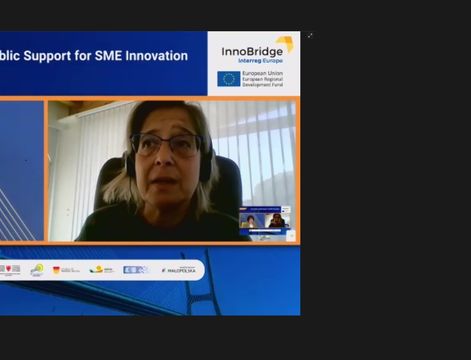
InnoBridge- COVID-19: reaction of Castilla y León
Adaptation of Castilla y León Innovation Ecosystems to the Covid-19 Health Emergency Situation
High regional expenditure on R&D does not necessarily lead to innovation and increased regional competitiveness if the regional economy is hampered by insufficient exploitation of its own R&D results and from a lack of access to public R&D results. Increasing SMEs’ competitiveness is at the core of the InnoBridge project by improving the Innovation Bridge and related policy instruments for SMEs: “Bridging the innovation gap through converting R&D results into commercial success in a more effective and efficient way”. This enables SMEs to better realise their innovation potential and to act as a catalyst for creating more high qualified jobs and regional growth.
The partnership consists of 9 partners from 8 regions in 8 countries spread over Europe with a balance of advanced and less advanced regions.
Project phase 1 (3 years) is dedicated to an intensive interregional exchange and learning process on the Innovation Bridge with involvement of regional stakeholders (Peer Reviews, Study Visits, Capacity Building Workshops, Staff Exchanges). This approach facilitates the development of Action Plans, which are implemented in phase 2 (2 years).
Strong involvement of the responsible authorities for the 8 addressed policy instruments – as direct partner or as stakeholder group member – ensures the durability of the implemented improvements and the long-term impact on SMEs’ innovativeness in the partner regions.
All instruments are part of RIS3, 7 instruments are dealing with Structural Funds. An estimated total amount of 30.4 M EUR, influenced through InnoBridge implementation demonstrates the strong leverage effect for regional and European policies as added value.
The InnoBridge Concept Paper with InnoBridge methodology, Good Practice knowledge pool and lessons learnt, summarises the exchange and learning process and is disseminated EU wide. The project is supported by intensive communication activities like website, newsletters, social media and 2 conferences.
€1,619,830.00
Research and innovation
The policy instrument is aiming at fostering the innovation capabilities of companies.
Two measures of Investment Priority 1(b) of the ERDF Operational Programme will be tackled with InnoBridge:
„M3_FTI_IP1b_MN1 Betriebliche F&E und Technologietransfer-Projekte“ (Business R&D and Technology Transfer Projects),
„M4_FTI_IP1b_MN2: Innovationsberatung und –förderung“ (Innovation Coaching and Support).
Both measures aims at supporting companies – with focus on SMEs – in their R&D and innovation activities taking into account the full innovation process “from the idea to the project”. Different types of support are addressed like innovation coaching, professionalization of innovation management, state aid schemes for SME’s R&D projects and technology transfer.
Research and development alone are not enough for economic success. That means that successful market placement is required. But a sufficiently strong focus on the exploitation of existing R&D results and knowledge is so far missing in both measures. Thus the aim within InnoBridge is to improve existing services and funding programmes, to close remaining gaps in support for mobilization of SMEs’ innovation potentials.
Castilla y León will deal specifically with priority Axis 1 “Fostering research, technology development and innovation” of the policy instrument. Within this axis, two measures will be tackled:
1) TCUE (part of Investment Priority 1.2) was launched in 2008 with the objective of fostering the University-Business knowledge transfer in terms of better exploitation of R&D results. Recently, the new Plan TCUE 2015-17 was approved under the umbrella of the RIS3. The new scenario of smart specialisation opens new opportunities for redefinition and improvement of TCUE. InnoBridge constitutes therefore a good opportunity to look for new potential approaches and ideas improving TCUE.
2) InfraRed (part of Investment Priority 1.1) is conceived as a partnership among public universities to acquire and share scientific equipment linked to collaborative projects, and fostering its availability to the whole public and the private scientific community. This is a new initiative in the region. InfraRed is envisaged as collaboration among universities, which can significantly enhance the access to technology of regional companies and the university-business collaboration in innovation projects. Scientific infrastructures can be at the core of innovation and therefore, InfraRed has significant potential for establishing synergies with TCUE (and therefore with Priority Axis 1.2). New ideas generated during the exchange of experiences of InnoBridge can significantly improve this aspect.
Within the Investment Priority 1(b) of the Priority axis 1 (RDI) the Autonomous Province of Bolzano – South Tyrol will focus on the measures 1.1 “Increase innovation in the companies” and 1.3 “Open new market for innovation”.
The measures aim at supporting local companies – with focus on SMEs – in their R&D and innovation activities as well as create the framework conditions to improve access to know-how and exploit R&D results. The idea is to do this on the one hand through the strengthening of the current support services such as those offered by the in house Agency TIS techno innovation South Tyrol Scpa, with focus on strengthening the role of clusters, networks and innovation poles. These also means to improve commercialisation of R&D and open new markets. On the other hand, also the financial support measures (such as innovation vouchers, funding for R&D projects, innovation consultancies, support to IPR and more) should be improved in order to guarantee to the companies access to knowledge and innovations which can boost the commercialisation potential of their R&D results.
The goal is therefore to continue to offer strong framework conditions for the support of local companies. The focus will be given to the knowledge-intensive sectors and to the sectors identified in the Regional Smart Specialization Strategy.
Within InnoBridge West Transdanubia will focus within the above mentioned policy instrument on the measure: Supporting R&D&I activities of companies.
The measure is supporting companies in their R&D&I activities focusing on the development of prototypes, product, innovative technology and services as well as on co-operation between companies and research institutes with the overall aim of creating an Innovation Ecosystem.
Supporting R&D&I activities of companies can be considerd as an old measure in Hungary. However the available financial grant was limited amount till now. In the current EU budget period Hungarian companies can apply for more significant fund from the tackled Operational Programme for development of their innovation activities.
This measure has not only regional but also national scale. This is a very important measure regarding the Hungarian innovation and economic development because of the share of the SMEs among the companies in Hungary is 99,9 percent. So SMEs play a key role in the national economy.
International collaboration in InnoBridge project can demonstrate a successful method how could be the SMEs – especially micro and small one - among the companies in higher rate supported in order to implement their innovation process with collaboration of research institutes included smaller co-operation projects in more efficient way.
Tampere Region will focus on “Open Innovation Platforms” which are addressed in the policy instrument under Investment Priorities 1(a) and 1(b). Open Innovation Platforms are their framework to create and develop RDI environment and platforms.
Since 2009 the region is experimenting with alternative open and platform-centric approaches for the development and revitalization of the innovation environment with great success and learning results. With novel co-creation platforms the region enables multidisciplinary co-creation, new combinations of knowledge, customer driven lean start-up creation, talent attraction and citizen participation in a sustainable and cost-efficient way. The current open innovation platforms such as Demola, Protomo, New Factory, Campus Arena and Mediapolis attract and bring together thousands of participating talents, hundreds of companies and SMEs and tens of research groups from the 3 universities of the region. Platform thinking is recently incorporated in the RIS3 of the region, the smart city strategies of the city of Tampere and various ecosystem initiatives of the region. Shared platforms are a foundation for new kind international partnerships globally. To increase the impact of the platform policy in terms of innovation and turnover with new products of platform members, wider adoption should take place in the region and cross-regionally. Also new practices of monitoring and communication (creation of positive image) need to be developed.
The ROP – Regional Operational Programme for Alentejo Region is the financial instrument that supports 2014-2020 Structural Funds implementation in the region.
The identified Investment Priority tackles specifically the support to R&D+I, fostering the link between R&D institutions and the productive sector. The state of the art regarding R&D+I in the region points out that there is a strong need to foster the articulation between the research and economy sectors to increase rates of innovation and strengthen regional competitiveness. The intervention of this Investment Priority in the territory will support specifically the SME’s and tackles issues like low interaction of companies with R&D organisations and the low share of new products.
Different types of support are addressed by this policy instrument such as investment in the creation of SME’s, state aid schemes for their R&D projects, collective actions for technology transfer, pilot projects and experimentation actions, among others.
But so far the regional innovation policy and in particular this policy instrument are not sufficiently taking into account the full innovation process “from R&D to product and market”, which is necessary for supporting SMEs in their R&D and innovation activities. Science – business collaboration has to be accelerated in particular as nowadays too many R&D results remain unexploited or are exploited by national and international companies, but not the regional entrepreneurs.
Sofia has limited local policy instruments to support innovation. The Sofia Fund for Innovations as a public-private fund with endowment has the objectives to mobilize resources to spur new business creation and to expand opportunities to participate in the economy to the city’s residents. By creating a unified regional economic community for the sustainable economic development of Sofia, it will provide interface with universities for R&D and a variety of direct and indirect support mechanisms for R&D.
The policy instrument is already considered as a good European practice by the Culture for Cities and Regions, EUROCITIES in 2015.
The instrument will deliver support to projects that are so far not sufficiently succeeding in terms of innovative products and turnover creations with these products. In addition, it is expected to boost pilot initiatives and a bigger number of partnerships between business and R&D organizations. With the expansion of the Fund, it is also expected that the turnover of supported innovative solutions by the Fund will increase in relation to funding from other public sources.
The ambition of the Fund is to contribute to increasing the technologically intensive SMEs from 24% to 32% by 2023.
Sofia Fund of Innovation is so far limited in scale, scope and effect.
The Malopolska Region will focus on Measure 1.2 Research and innovation in enterprises within the Investment Priority 1(b), Priority axis 1: Knowledge economy.
The objective of the measure is to increase commercialisation of R&D by regional enterprises-in particular SMEs–in the fields of smart specialisation. The instrument is going to do this by financial support for:
a) R&D projects of enterprises
b) R&D infrastructure of enterprises
c) first step of business and science cooperation (in form of Innovation Vouchers).
The selected policy instrument goes hand in hand with the Working Groups for Malopolska Smart Specialisations which have been established to continue and even to accelerate the entrepreneurial discovery process, to indicate the most promising areas within the smart specialisation areas of Malopolska and to accelerate the exploitation and commercialisation of R&D+I.
Further improvement is required in terms of:
• fine-tuning to get its optimum level within the programming period (the implementation of the instrument will start in 2015).
• special concern and valuable know-how for required improvement as the instrument is the most important source of EU funds in the Region for stimulating cooperation and R&D commercialisation.
• tackling a crucial problem in the Malopolska Region: so far successful cooperation of business and science has been happening relatively seldom. Hence delivering the successful instrument is crucial for the development of the region.

Adaptation of Castilla y León Innovation Ecosystems to the Covid-19 Health Emergency Situation
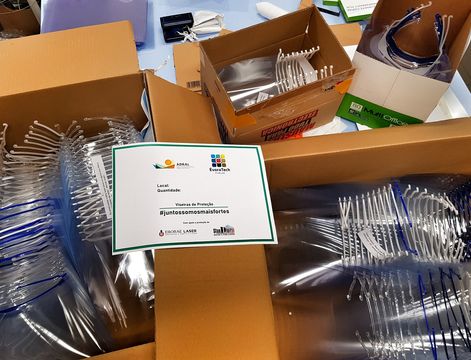
The Fablab ÉvoraTech – a good practice identified within the InnoBridge Project, is located in ÉvoraTech – Évora Technological Based Business Incubator
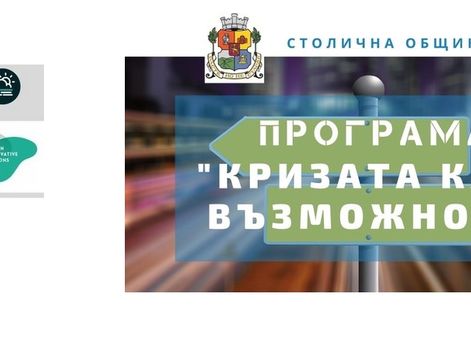
Sofia Public-Private Fund for Innovations launches a new funding scheme to support microenterprises and social enterprises in the post the COVID-19 crisis

EDIOP Measures to contain the economic consequences of the COVID-19 pandemic in Hungary

Article summarising Mrs Sylwia Bednarczyk-Mikuli presentation, Subject of presentation: “How to raise and mobilise the existing skills and how to build ...
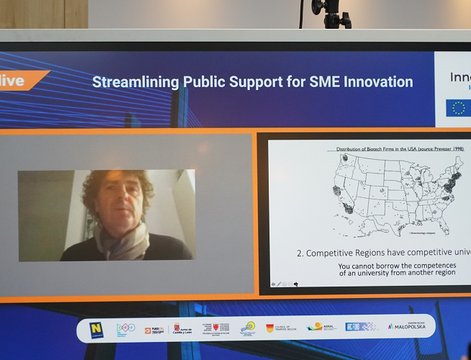
To foster entrepreneurship, entrepreneurial ecosystem should display all the elements, but most importantly these elements have to collaborate.
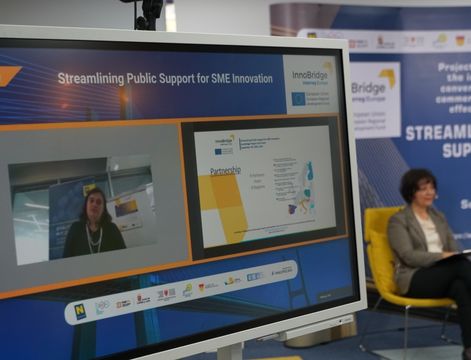
The technology and innovation partners (TIP) of Lower Austria support companies in the implementation of innovation projects.
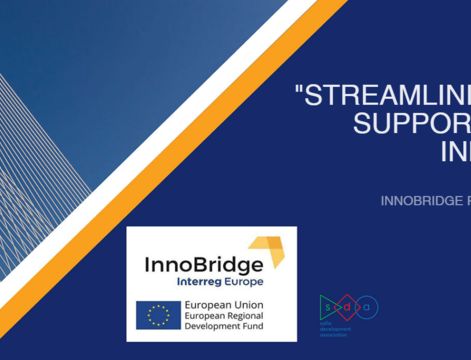
“Streamlining Public Support for SMEs and Innovations” - InnoBridge project final international conference, 30 September 2020, Sofia

Adaptation of Castilla y León Innovation Ecosystems to the Covid-19 Health Emergency Situation
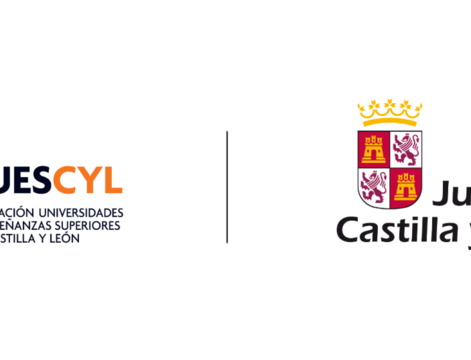
Castilla y León Action Plan, developed within INNOBRIDGE, is an essential part of the Regional University-Business Knowledge Transfer Plan (TCUE Plan) 2018-2020